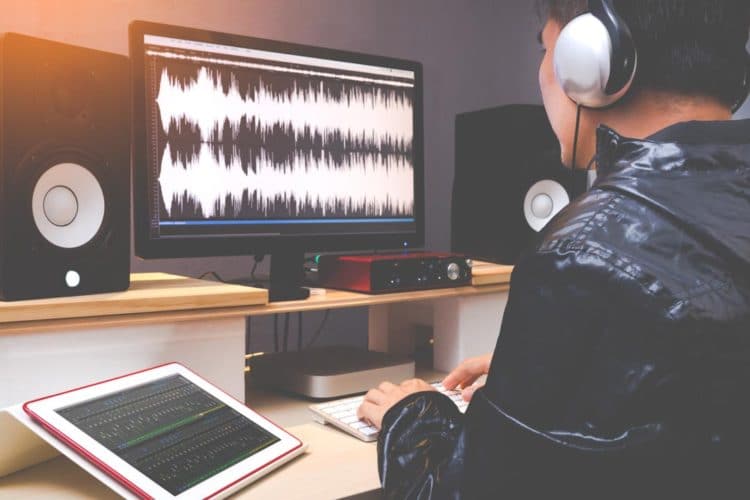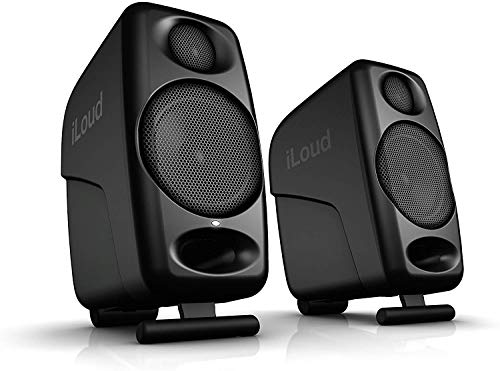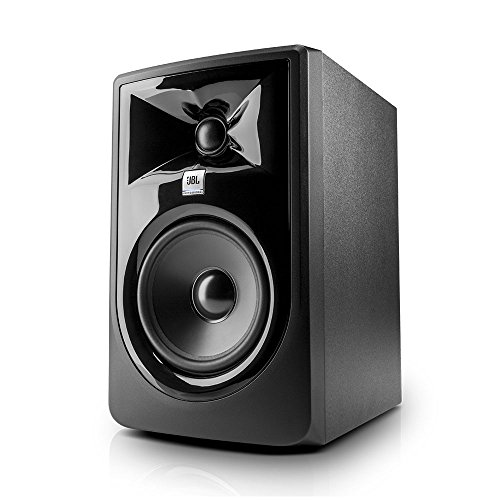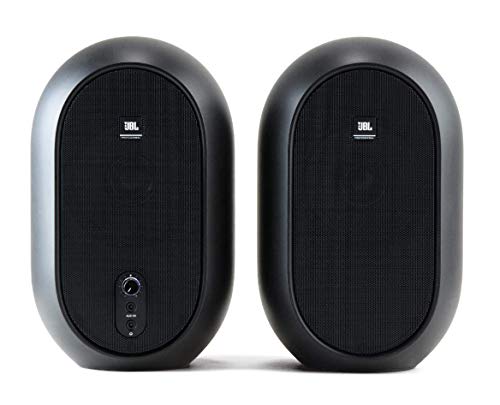Small studio monitors enable artists to create a home recording area on a restricted budget. You can turn a tiny space into a place where the magic happens with this equipment.
The upgrade from your built-in computer audio ensures that every frequency gets heard while you record, edit, and master each track.
When looking for the best small studio monitors for home use, it is essential to maximize your investment.
Price is not always the determining factor for discovering high-quality manufacturing processes. Reviewing each brand and unit to see if it meets your needs is still the most effective way to shop.
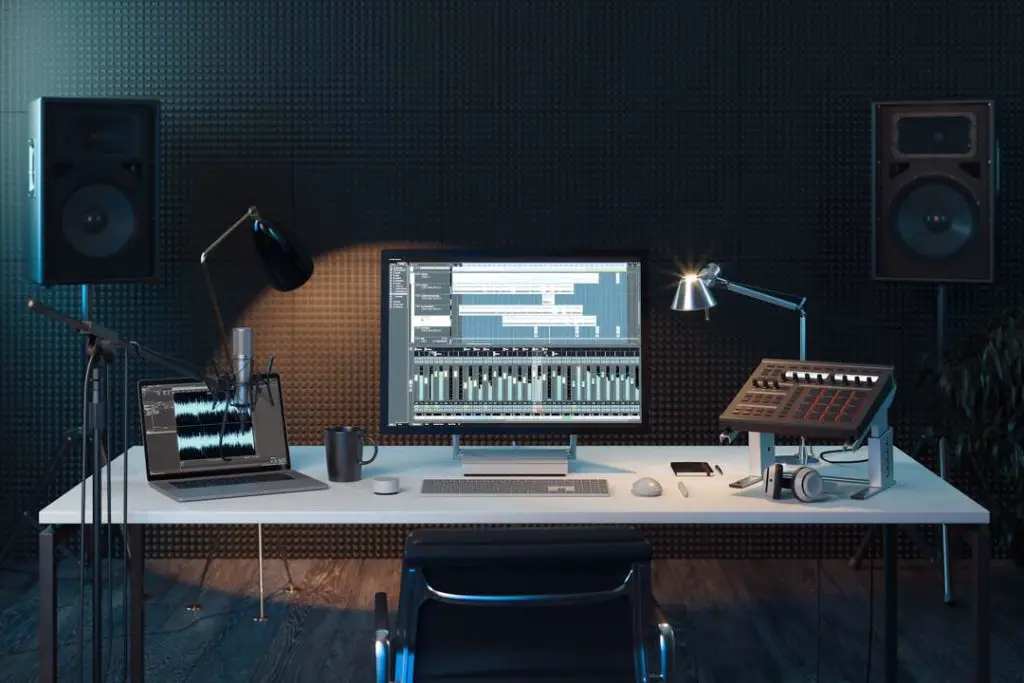
What to Consider When Buying Small Studio Monitors
1. Speaker Size
Small speakers work well for audio in the mid-range because of the size of the LF drivers.
You’ll experience clarity with vocals, string-based instruments, and recorded pianos.
Although it doesn’t manage bass frequencies well, you can still get a feel for the beat when investing in studio monitors.
In this category, most studio monitors feature a two-way speaker design that sends the split frequencies to different outputs.
Several manufacturers put them in the one-inch size, although there is some variation. Larger woofers will give you more bass, so invest in that direction if your tracks feature low Hertz levels.
2. Frequency Response
This rating represents the frequency range that the small studio monitors can handle. Some products have a slight difference between the two extremes, while others have significant variations.
When you have access to full frequency response, the speakers can handle more music types.
Artists that work primarily with acoustic instruments find that small studio monitors provide the flatness needed to pick out the mid-range tones for listening or recording.
It may be necessary to have more than one set of monitors available to review each frequency set to deliver the best results.
3. Power Rating
Small studio monitors receive a power rating based on the volume, headroom, and speaker size of the product.
You need the equipment to fill the room with a discernable sound that doesn’t get distorted or muddied like a subpar Bluetooth connection.
The volume should feel exciting instead of tiring, being loud enough to pick out individual frequencies without disturbing other rooms.
You should experience equal quality at low volume levels compared to louder sounds with the best small studio monitors for home use.
4. Monitor Positioning
Small studio monitors should provide a variety of positioning methods to give you the most versatility with your setup.
Each room has unique acoustics that requires some tinkering to achieve positive results. If the unit’s design forces you to install the speakers in a specific location, the sound frequencies may cancel themselves out – leaving you with dead space where you work.
Although larger monitors provide more flexibility, it is sometimes better to have a limited range with which to work. You can overwhelm a small room with too much sound.
5. Surroundings
Most home-based artists work within an untreated room when recording audio. That means your pickups could grab some sounds from an adjoining space or the outside environment.
Smaller monitors enable you to check for frequency balance to avoid uneven resonances and bouncing frequencies.
If you receive audio interference from outside sources, the best small studio monitors cannot help the recording.
You’ll need frequency absorbers, such as carpeting and wall diffusers, to reduce the impact of the outside environment.
6. Equipment Materials
Most studio monitors are a combination of paper and plastic components with metal foundations.
Some items come in wooden or Kevlar cabinets and structures, although the most common material is an aluminum alloy.
Ignore the marketing language when shopping in this category. Only purchase items made with high-quality materials and craftsmanship to receive a consistent performance.
12 Best Small Studio Monitors for Home Use
Whether you’re looking for a great option for small rooms or if you just need the best compact studio monitors, you’ll definitely find the ideal solution for your specific needs down below.
Here are the 12 best small studio monitors in 2023:
- PreSonus Eris E3.5 Studio Monitor
- IK Multimedia iLoud Micro Monitors
- Edifier R1280T Studio Monitor
- PreSonus Eris E5 Near Field Studio Monitor
- IK Multimedia iLoud MTM Small Studio Monitor
- Yamaha HS5 Studio Monitor
- JBL Professional 305 Mark II Studio Monitor
- Behringer MS16 Small Studio Monitor
- Yamaha HS8 Studio Monitor
- Behringer K8 Small Studio Monitor
- KRK RP7 Rokit 7 G4 Studio Monitor
- JBL Professional 1 Series Studio Monitor
Let’s find out more about each one:
1. PreSonus Eris E3.5 Studio Monitor
Here is what to expect with the Presonus Eris E3.5 small studio monitors:
- Driver: 3.5-inch Woofer, 1-inch Silk Dome Tweeter
- Amplifier: 25W per speaker (not bi-amped)
- Inputs: 1 x XLR, 1 x 1/4″ TRS, 2 x RCA
- Frequency response: 80 Hz – 20 kHz
- Crossover Frequency: 2.8 kHz
- Enclosure: Rear Ported
- Controls: Volume, MF Control, HF Control, Low Cut, Acoustic Space
- Dimensions: 6.4 x 5.6 x 8.3 inches
- Weight: 6.82 pounds
This studio monitor from Presonus uses a medium-density fiberboard with vinyl laminate to create the enclosure.
Because these premium speakers have a smaller footprint and the bi-amped design, it seems like the logical thing to do.
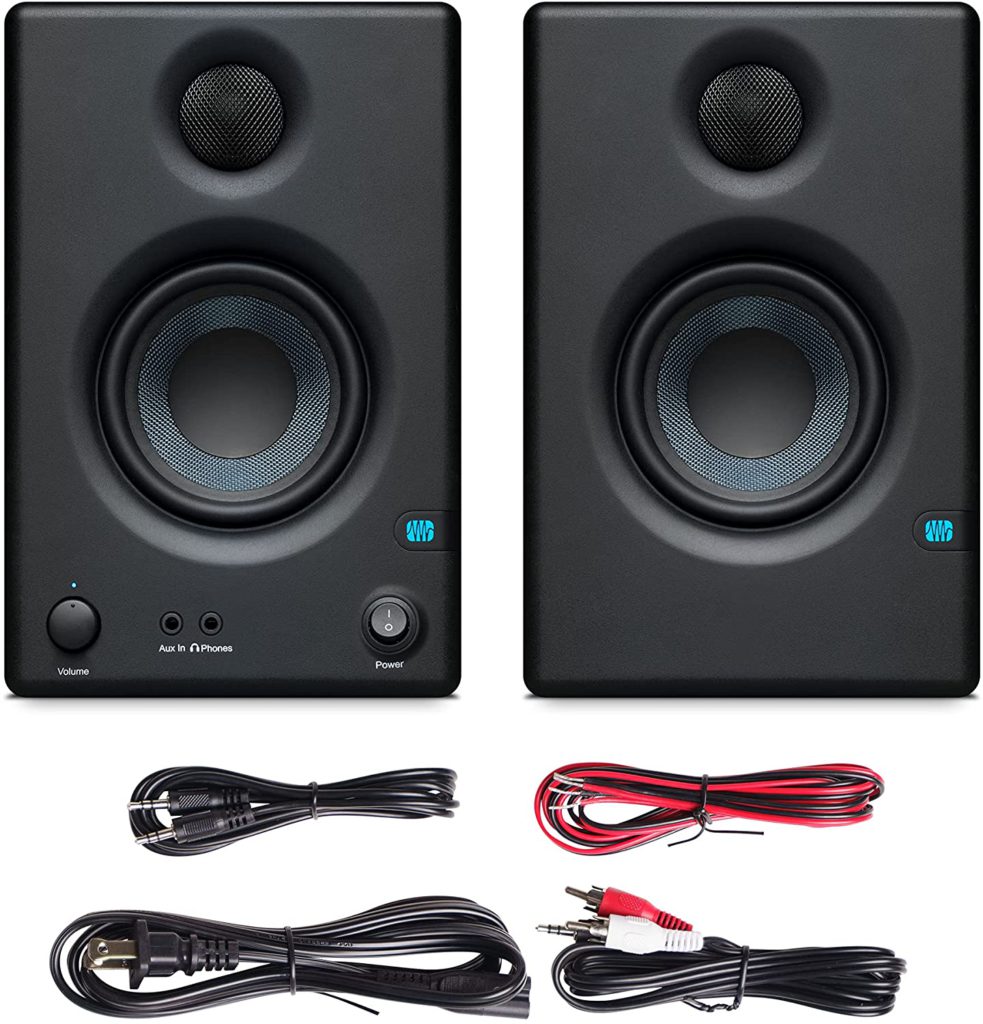
If you don’t have a lot of space, most of the best small studio monitors will overwhelm your area, making it impossible to distinguish the individual frequencies.
This design eliminates that problem. Artists can connect it to almost any sound source in the room, use their smartphone, or hook up headphones for private listening.
There is virtually no distortion from these studio monitors and you’ll receive a smooth response with balanced highs to create incredible, authentic sounds.
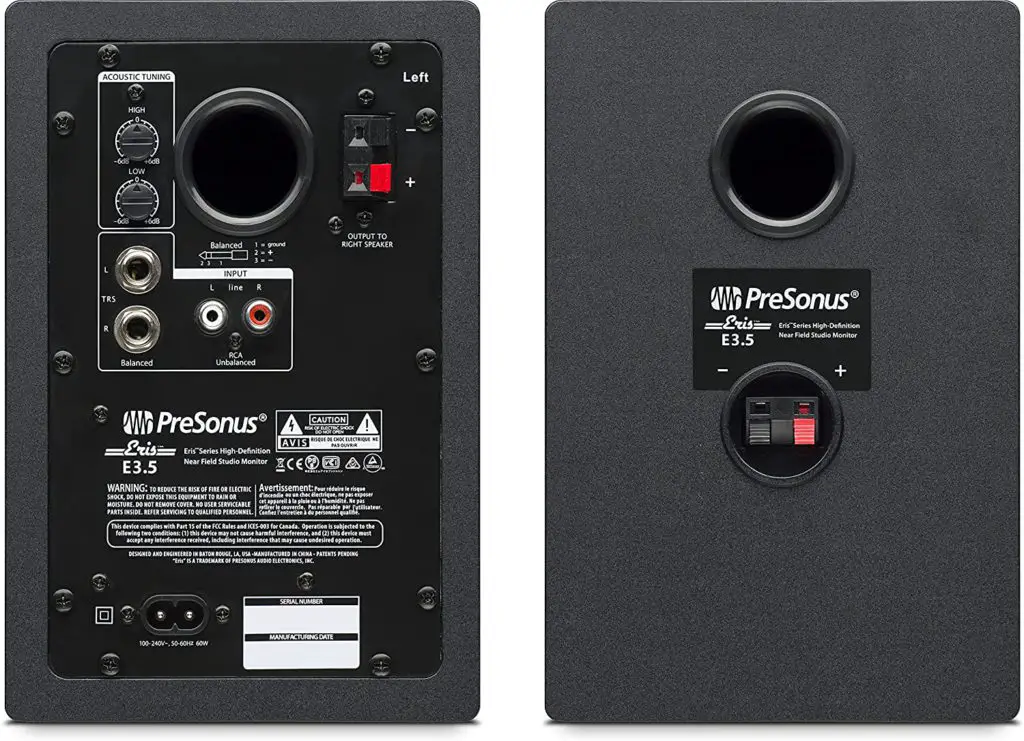
What you create with this equipment translates well to another stereo. Although you wouldn’t want to put this product next to a wall, the acoustic tuning controls let you shape the harmonics appropriately to create a perfect mix.
You’ll discover plenty of gain and lots of headroom for a surprisingly low price when choosing this studio monitor.
2. IK Multimedia iLoud Micro Monitors
The iLoud Micro Monitors feature these specs:
- Driver: 3-inch Neodymium Woofer, 0.75-inch Silk Dome Tweeter
- Amplifier: 18W LF, 7W HF (RMS)
- Inputs: 4-pin, 1 x 1/8-inch TRS, 2 x RCA
- Frequency response: 45 Hz – 22 kHz
- Crossover Frequency: 3 kHz
- Enclosure: Ported
- Controls: EQ switches, rear-mounted volume, Bluetooth
- Dimensions: 7.09 x 5.31 x 3.54 inches
- Weight: 3.79 pounds
You won’t find smaller or more portable speakers for multimedia or recording needs than these.
You still receive high-end sound quality finish with a surprisingly good bass response. It may be miniature in size, but the range of frequencies it supports is quite broad.

The speakers are loud enough to fill any small space with authentic sound. Bluetooth functionality improves the user experience, while physical controls help to create something lifelike while listening.
Adjustable isolate bases can decouple the studio monitor from the bookshelf or desk to send the audio closer to your ears.
Three EQ switches work to adjust for minor room issues when creating a studio space. You can stream music instantly, focus on a jam track, or relax to your favorite playlist at the end of the day.
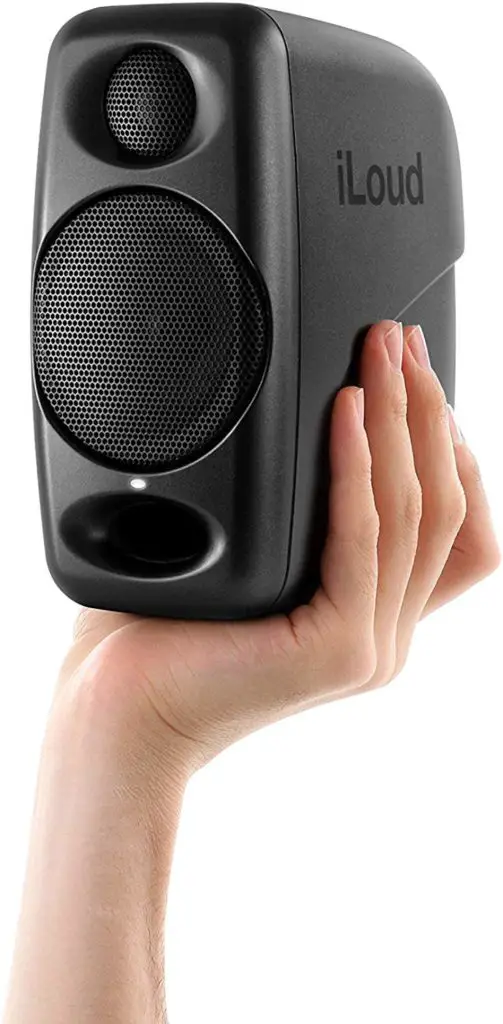
You may need to roll off the bass by a few decibels to prevent over-processing the highs with your setup.
A/B work with mastering is impressive with this tech, especially for the price. It may be simple and unpretentious, but the monitors get the job done.
3. Edifier R1280T Studio Monitor
The Edifier R1280T small studio monitors feature the following specs:
- Driver: 4-inch Woofer, 13mm Silk Dome Tweeter
- Amplifier: 21W per speaker (not bi-amped)
- Inputs: 2 x RCA
- Frequency response: 75 Hz – 18 kHz
- Crossover Frequency: Not specified
- Enclosure: Ported
- Controls: Volume, MF Control, HF Control, Low Cut, Acoustic Space
- Dimensions: 5.7 x 9.5 x 7 inches
- Weight: 12.45 pounds
With a distortion rating of less than 0.05%, this studio monitor is one of the most accurate in the industry today.
It comes with dual RCA inputs for improved connectivity to several audio sources. You also receive a wireless remote control to manage volume or mute when necessary.
These bookshelf speakers feature a retro look that still produces modern audio quality.
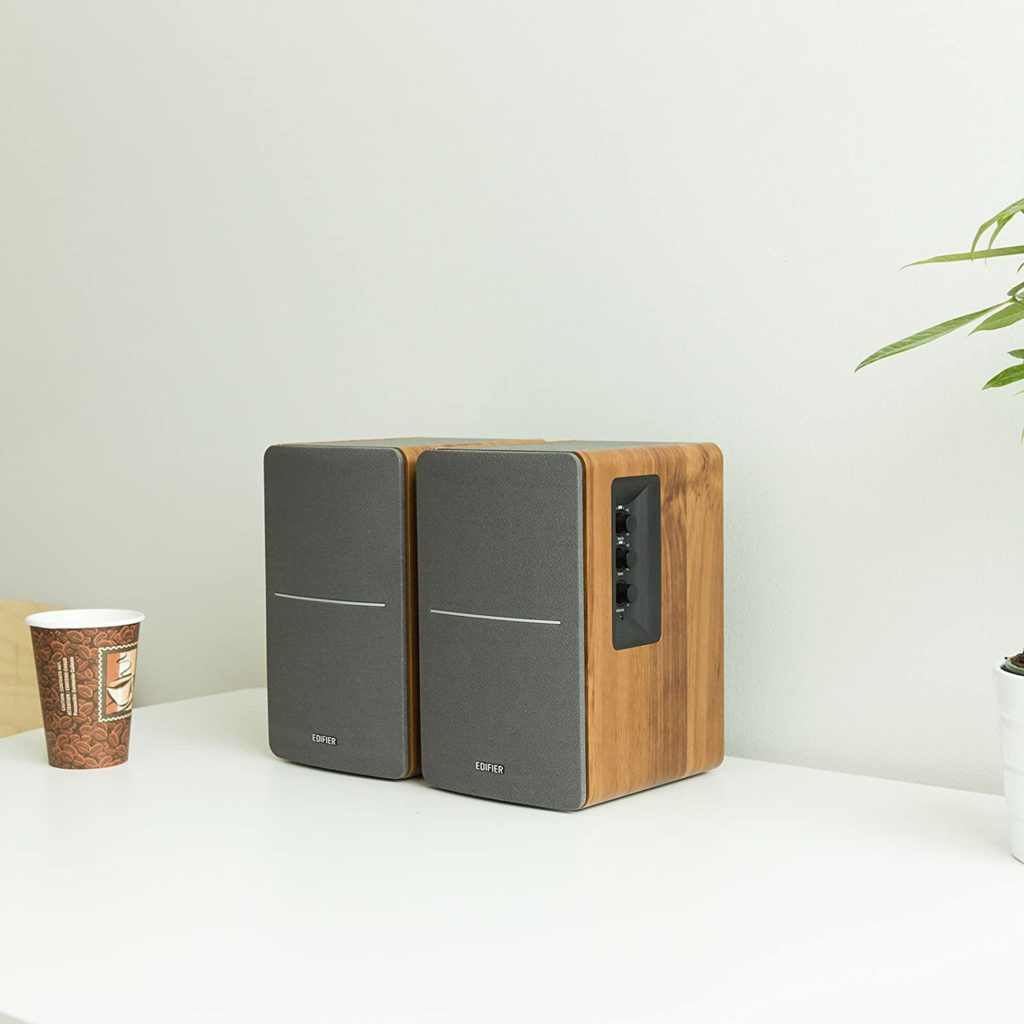
A four-inch bass driver works with a flared reflex port to create sound frequencies that give you more depth than in competitive products.
You receive precise controls for treble and bass volume to make whatever micro-adjustments are necessary for the performance you want.
The controls for the unit are on the right side of the speaker. If you decide to swap them during your set up, the green light becomes visible.
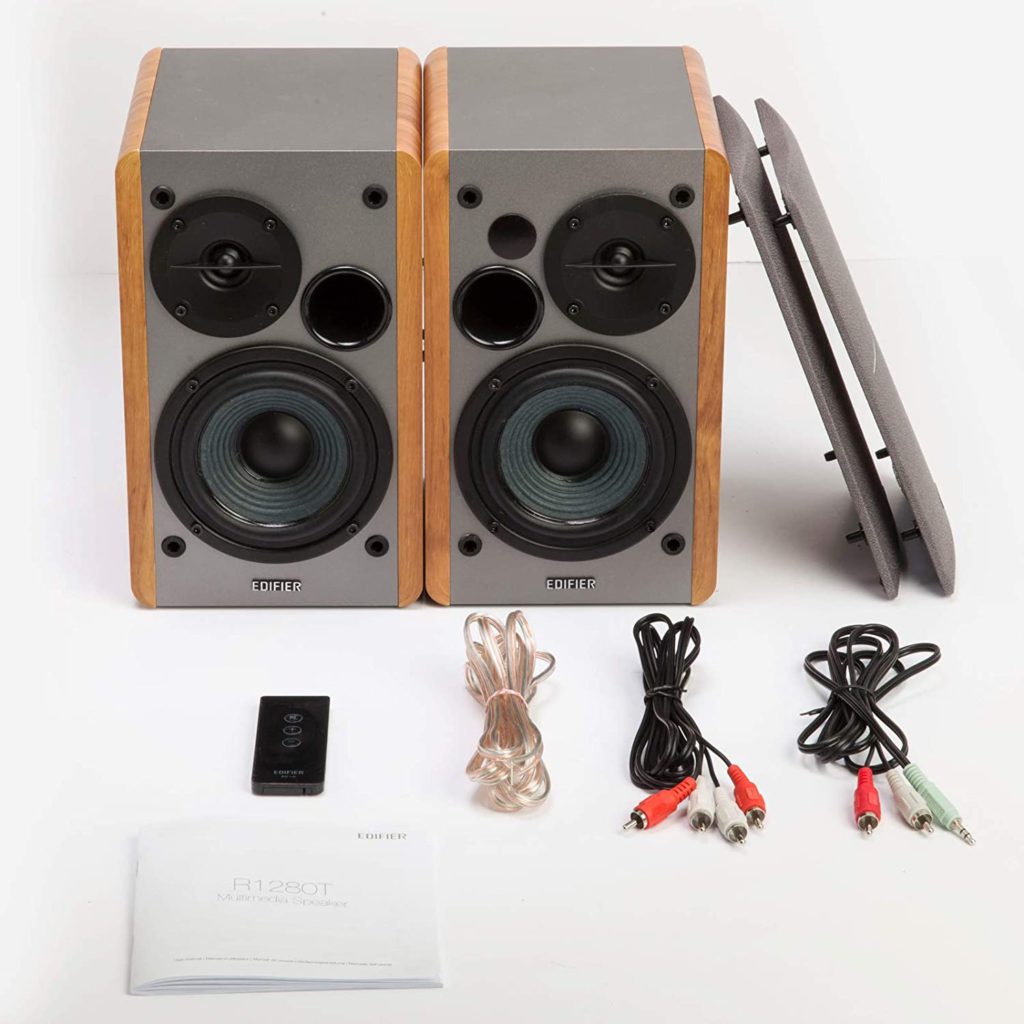
Some users may prefer a Bluetooth connection, which is not available with this design.
Convenient connections are possible to any device with the dual RCA output. You also receive a 3.5mm headphone output.
Two methods can go through the AUX simultaneously without the need for plugging and switching.
This studio monitor comes with a two-year warranty for parts and labor.
4. PreSonus Eris E5 near Field Studio Monitor
Here are the Presonus Eris E5 Near Field small studio monitor specifications to review:
- Driver: 5.25-inch Woofer, 1-inch Silk Dome Tweeter
- Amplifier: 45W LF, 35W HF
- Inputs: 1 x XLR, 1 x 1/4-inch TRS, 1 x RCA
- Frequency response: 53 Hz – 22 kHz
- Crossover Frequency: 3 kHz
- Enclosure: Ported
- Controls: Volume, MF Control, HF Control, Low Cut, Acoustic Space
- Dimensions: 10.24 x 7.68 x 7 inches
- Weight: 10.2 pounds
The size of this small studio monitor is what you notice first. Although it appears as if you’re getting less for your money with its overall design, you are getting more for your investment.
It offers a subtly larger diaphragm to give the low frequencies a boost, providing clarity at working volumes without interference or frequency bouncing issues in most spaces.
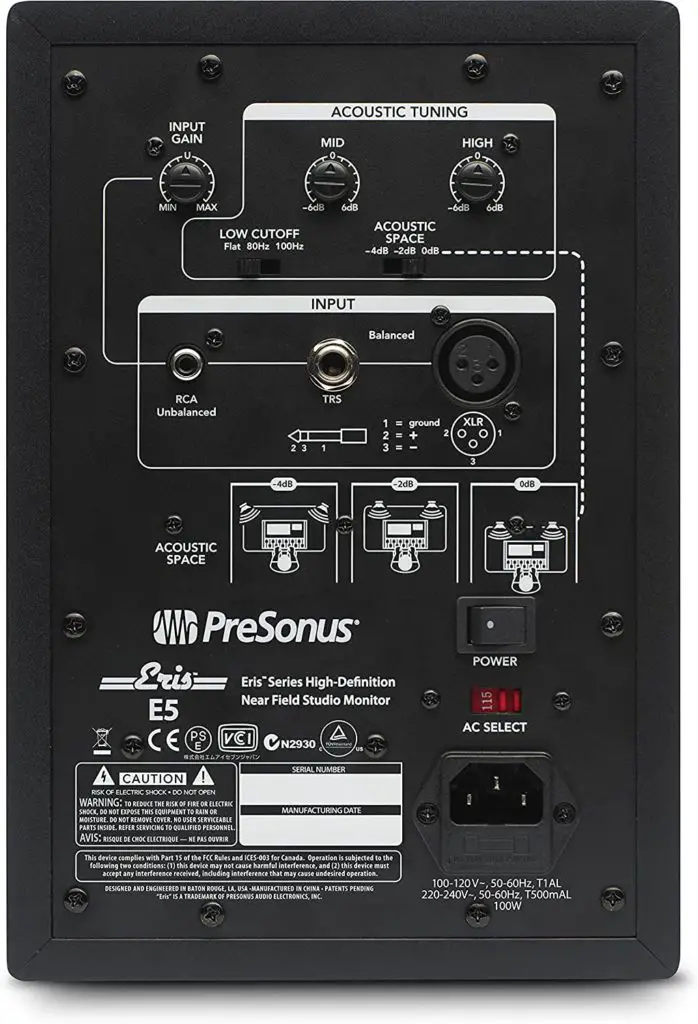
Even though it can be challenging to find the sweet spot with this studio monitor, solo musicians will appreciate what this equipment provides.
It allows you to mix on your DAW with ease, record with confidence, and build sounds that reach new dimensions.
PreSonus has the bass port firing forward to reduce the behind-speaker resonance problems that competitive products experience.
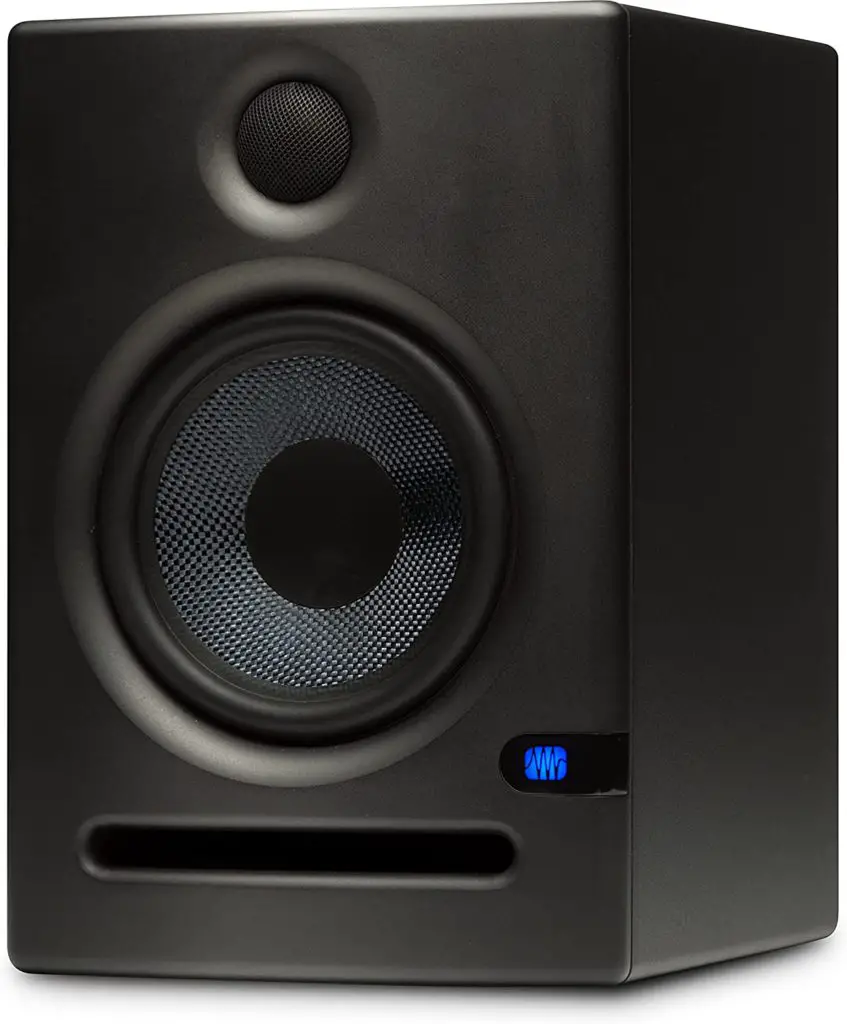
It’s one of the few products at this price point that offers mid-range fidelity with low-frequency support.
You won’t get it to compete with professional-grade equipment or diaphragms that are twice its size. Still, the design gets the job done for anyone working in a home studio or small setup.
5. IK Multimedia iLoud MTM Small Studio Monitor
Here are the specs listed for the iLoud MTM small studio monitors:
- Driver: 3.5-inch Woofer, 1-inch Silk Dome Tweeter
- Amplifier: 70W LF, 30W HF (RMS)
- Inputs: 1 x XLR, 1 x 1/4-inch TRS, 1 x USB
- Frequency response: 50 Hz – 24 kHz
- Crossover Frequency: 3.1 kHz
- Enclosure: Ported
- Controls: Volume, MF Control, HF Control, Low Cut, Acoustic Space
- Dimensions: 10.39 x 6.3 x 5.12 inches
- Weight: 5.5 pounds
Although it offers a surprisingly compact size, the detailed sounds from this studio monitor are remarkably excellent.
The design features internal ARC calibration tech that compensates for the deficiencies found in most small rooms.
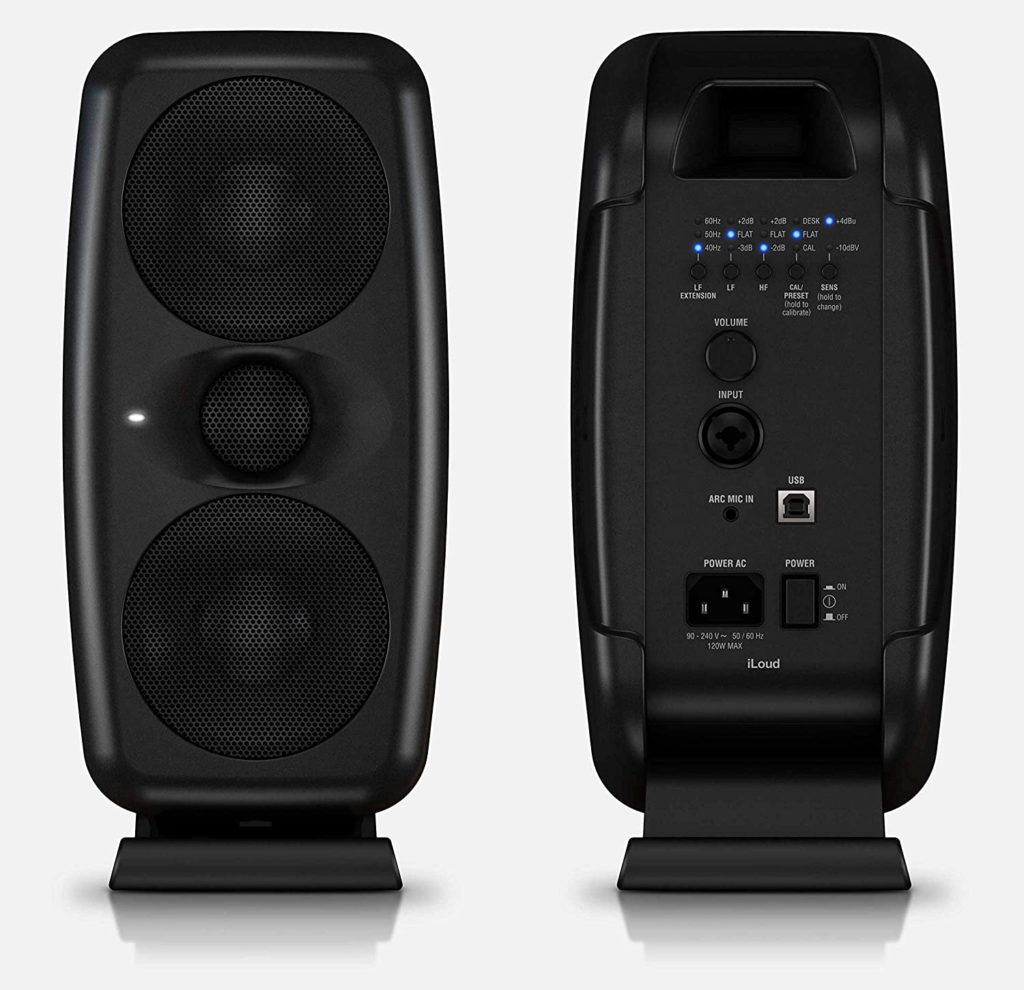
With the improvements to the acoustics apparent immediately, it makes the work of producing an authentic recording or mixes a lot easier.
The design of the studio monitor includes a tilting stand to create a custom experience when needed.
It may be smaller than most speakers, but you would never know it because of the sound it produces. With low-frequency extension and trim controls, you can modify the response to virtually any taste.

What makes the iLoud MTM small studio monitors unique is their genuine portability. Most manufacturers talk about how their speakers can go anywhere, but this design backs up that claim.
When you want to work with friends or take your recording studio mobile, this unit is the best one in the industry to offer that flexibility.
Even though the custom calibration is not always as accurate as one might hope, the positives far outweigh any of the issues found with this product.
6. Yamaha HS5 Studio Monitor
These are the specs to consider on the Yamaha HS5:
- Driver: 5-inch Woofer, 1-inch Tweeter
- Amplifier: 45W LF, 25W HF
- Inputs: 1 x XLR, 1 x 1/4-inch TRS
- Frequency response: 54Hz – 30kHz
- Crossover Frequency: 2 kHz
- Enclosure: Ported
- Controls: Level, Room Control, High Trim, Power
- Dimensions: 11.2 x 6.7 x 8.7 inches
- Weight: 11.7 pounds
This small studio monitor is an excellent entry-level product for anyone who wants to create a DIY studio.
The sound quality it offers is incredible, providing a neutral response that’s perfect for vocals and stringed instruments.
Yamaha includes a room control feature on this unit to help with the calibration process for those working in limited spaces.

Experienced sound engineers will notice the lack of low-frequency support from these studio monitors immediately.
The lack of volume the unit offers could be problematic for some recording needs. Pairing it with a subwoofer could resolve this issue.
However, anything with a small diaphragm won’t replicate the bass hertz levels some artists may want.
Yamaha does try to counter this issue with the two-way bass-reflect bi-amplification design. It also comes with High TRIM response controls to help you manage unbalanced signals.
As a general-purpose studio monitor, it gets the job done. It may not work for advanced mastering, but that work falls outside of its purpose anyway.
A mountable version is available for those who don’t have the floor or desktop space.
7. JBL Professional 305 Mark II Studio Monitor
Here is what you can expect with the specs of the JBP Professional 305P Mark II:
- Driver: 5-inch Woofer, 1-inch Tweeter
- Amplifier: 41W LF, 41W HF
- Inputs: 1 x XLR, 1 x ¼-inch TRS
- Frequency response: 49Hz – 20kHz (±3 dB), 43Hz – 24kHz (-10 dB)
- Crossover Frequency: 1725Hz
- Enclosure: Ported
- Controls: Input Sensitivity, Boundary EQ, HF Trim, Volume
- Dimensions: 11.75 x 7.3 x 9.1 inches
- Weight: 10.43 pounds
This small studio monitor may have the best pound-for-pound sound quality in the industry today.
It features an excellent high-end performance that produces almost lifelike sounds within an enclosed environment.
If you need mid-range support, you’ll get the required accurate response for your instruments and vocals.
The build quality from JBL is one of the best that you’ll find at any price point. It contributes to the audio nuances that come from this monitor, despite the size of its five-inch woofer.
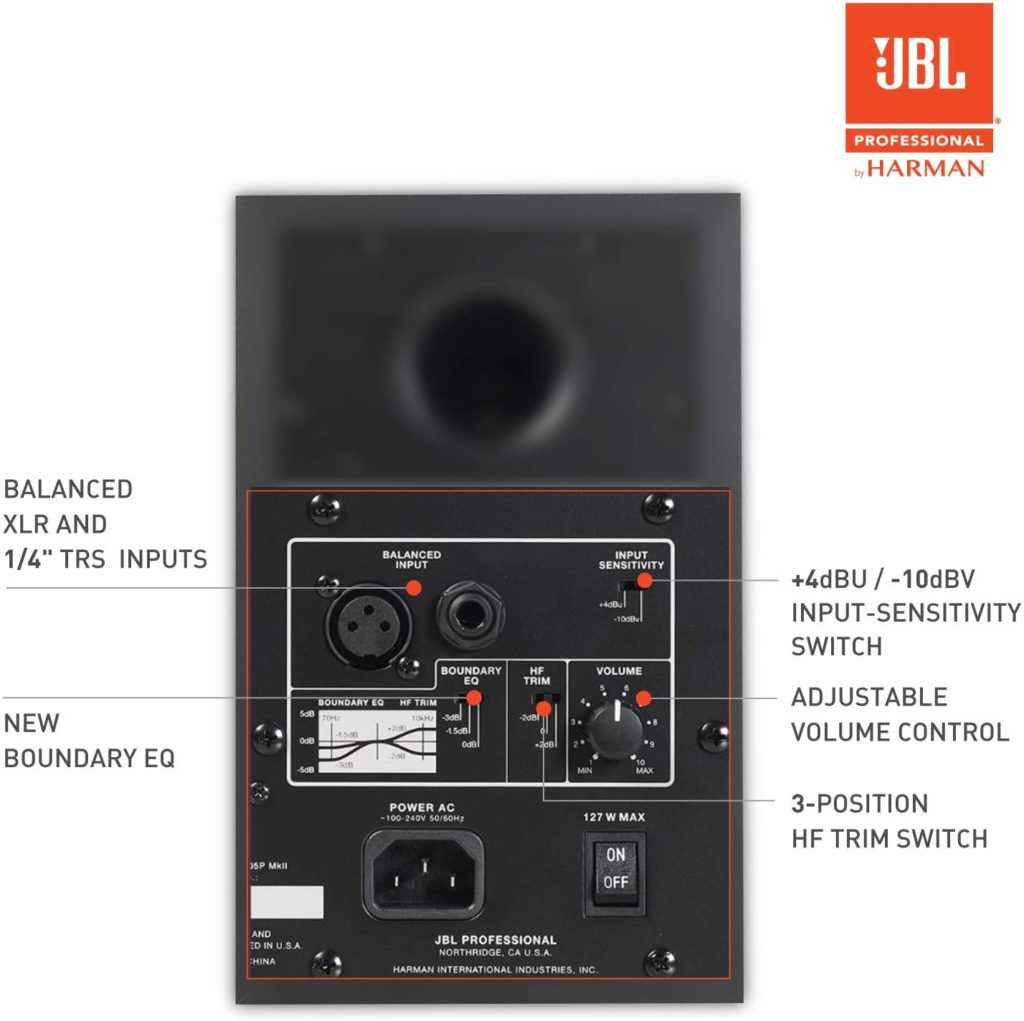
Although distortion can happen when you push the speaker hard, the same fault could be said of any other product of a similar size.
JBL uses a new boundary EQ with this studio monitor to restore the neutral response by placing the speakers on a working surface or next to a wall.
That design keeps the sweet spot broad so that fine-tuning your mix is possible, even if you’re listening off-axis.
Although the low end is quite lacking, you won’t get an unrealistic projection unless your environment isn’t well-suited for recording.
You can even counter that issue with some upgrades to your frequency absorption along the walls, ceiling, and floor.
8. Behringer MS16 Small Studio Monitor
You’ll get the following specs when choosing the Behringer MS16 two-way active near-field monitors.
- Driver: 4-inch Woofer, 1.5-inch Silk Dome Tweeter
- Amplifier: 8W per speaker (not bi-amped)
- Inputs: 1 x 1/4″ TRS, 4 x RCA
- Frequency response: 80 Hz – 20 kHz
- Crossover Frequency: Not specified
- Enclosure: Ported
- Controls: Volume, TRS Volume, Bass Control, Treble Control
- Dimensions: 5.9 x 5.5 x 9.4 inches
- Weight: 4.6 pounds (right) 3.1 pounds (left)
This speaker design provides you with plenty of versatility if you’re willing to make a few compromises.
It isn’t going to be a high-end studio monitor. Still, it can provide support for your audio recording, mixing, and playback needs.
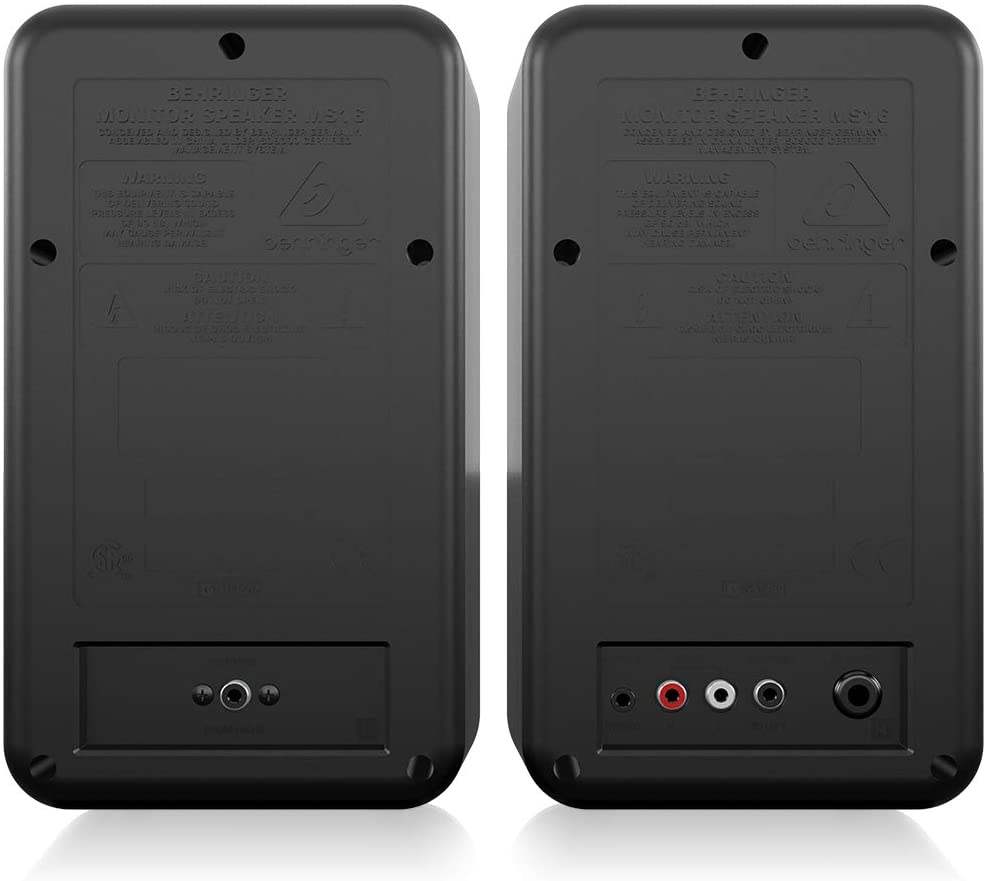
It works well for most multimedia, especially for those who love to listen to vinyl.
You can use it for music monitoring applications, have the speakers with your desktop, or use it with an entry-level DAW to experiment with recording.
You’ll get plenty of mid-range support with this design from Behringer. It does a better job on the high range than the low, although the sounds still feel authentic when listening in an enclosed space.
Some users may find that the audio sounds hollow when you crank up the volume because of the cabinet design’s bulkiness.
It is one of the few products at its price point that offers simultaneous audio monitoring through the unit.
Although the studio monitor is more for entertainment than professional applications, it is still a lot of fun to use.
9. Yamaha HS8 Studio Monitor
These are the Yamaha HS8 specifications to review:
- Driver: 8-inch Woofer, 1-inch Dome Tweeter
- Amplifier: 75W LF, 45W HF
- Inputs: 1 x XLR, 1 x 1/4-inch (TS)
- Frequency Response: 38 Hz to 30 kHz
- Crossover Frequency: 2 kHz
- Enclosure: Ported
- Controls: Level Knob, Room Control Switch, High Trim Switch
- Dimensions: 9.8 x 15.4 x 13.1 inches
- Weight: 22.5 pounds
The Yamaha HS8 Studio Monitor takes the advancements made by the NS10 to the next level.
It comes with a mountable option, features high trim response controls, and offers TRS and XLR phone jack inputs. It produces an excellent low distortion sound with a clear bottom.
This unit provides reliable and accurate frequency representations, even with its small design. Its quality at this price point is almost beyond compare in this category.
Although you can sometimes pick up some interference from other devices, you’ll have a better low-end response and high-trim controls to make whatever adjustments are necessary for your recording needs.
As with most small studio monitors, what you receive in the bass frequencies won’t compare to larger, more traditional units.
There can be some issues with resonance and audio reflection in smaller spaces because of the design.
The affordability here cannot be ignored. It comes with a flat frequency response that’s perfect for general recording needs.
It looks fantastic with your home setup, gets the job done, and is a safe investment for anyone just starting their creative journey.
10. Behringer K8 Small Studio Monitor
Expect these specs when reviewing the Behringer K8 Studio Monitor for home use:
- Driver: 8-inch Woofer, 1-inch Tweeter
- Amplifier: 150W total
- Inputs: 1 x XLR, 1 x 1/4″, 1 x RCA
- Frequency response: 40Hz to 20 kHz
- Crossover Frequency: 3 kHz fixed
- Enclosure: Ported
- Controls: Input Sensitivity, HF shelf, LF shelf, Room Compensation
- Dimensions: 15.5 x 10.3 x 12.4 inches
- Weight: 19.2 pounds
Although this small studio monitor doesn’t give the flattest response in small spaces, you’ll get an authentic representation of your mix.
The mid-range is exceptionally rich, with a preference toward the bass tones that can fool you into thinking a bad master is a good one on other products.

It does have a little bloat, but nothing that isn’t within the expectations of this design.
If you use the Behringer K8 for its intended use, you’ll get a lot of mileage with this investment. It isn’t intended to be a party speaker or something to use for an intimate gig.
Although you could get away with some home Hi-Fi with it, the product works best as a studio addition.
Two separate amps create an excellent sound reproduction experience.
The versatility of these small studio monitors is its greatest attribute. You can customize the listening experience to focus on whatever frequency group you prefer.
Anyone familiar with KRK equipment will experience a moment of Deja Vu with the sound signature from this monitor. It also feels more refined with its larger woofer and generalized low-frequency push.
The advanced waveguide technology creates an impressive acoustic dispersion that makes it quite easy to find the sweet spot with this option.
11. KRK RP7 Rokit 7 G4 Studio Monitor
You’ll get the following specs with the KRK RP7 Rokit:
- Driver: 6.5-inch Woofer, 1-inch Kevlar Aramid Fiber Tweeter
- Amplifier: 145W total, bi-amped
- Inputs: Combo Input XLR, 2 x RCA
- Frequency response: 42 Hz to 40 kHz
- Crossover Frequency: 2.04 kHz fixed
- Enclosure: Ported
- Controls: Graphic EQ, HF shelf, LF shelf, Room Compensation
- Dimensions: 13.35 x 8.86 x 11.19 inches
- Weight: 16.76 pounds
The Rokit G4 is the fourth-generation of a studio monitor design that never fails to satisfy.
It features a professional-grade design, low-distortion Kevlar drivers, and a Class D power amp with a brickwall limiter.
You’ll find the high-frequency wave guide optimization is spot on, creating a dynamic sweet spot with incredible imaging.
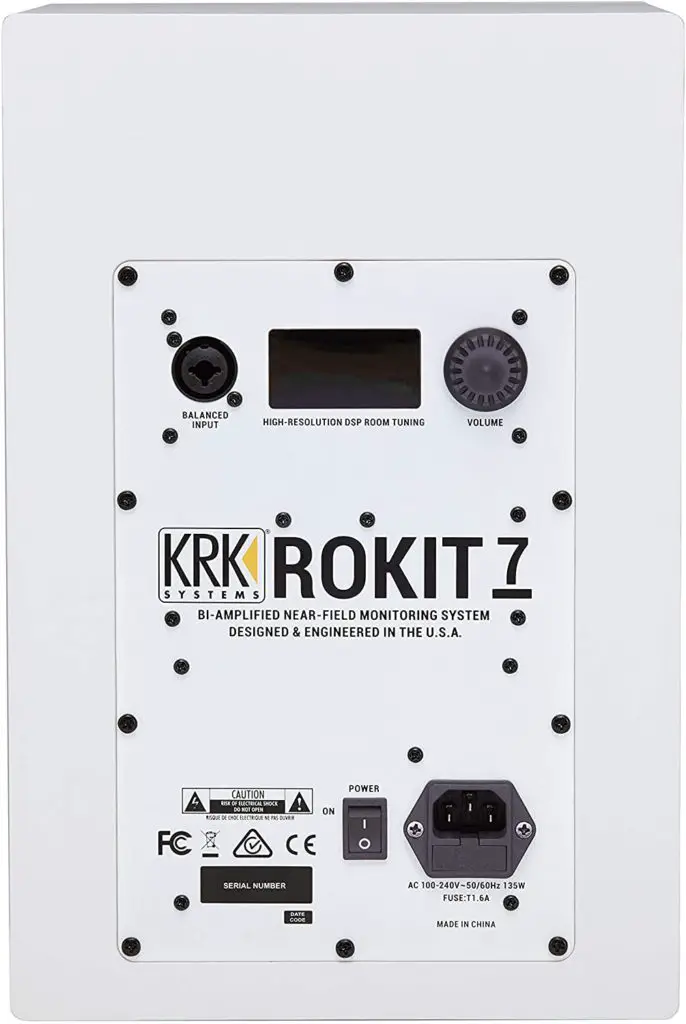
These studio monitors place the bass ports at the front of the cabinet, near the bottom, to reduce issues with wind blasts and distortion. It creates a strong response with plenty of punch for an authentic mix.
The low-end response is still excellent, even with the focus on the other end of the spectrum.
Attach the optional faceplate with a protective grill for more acoustic support if needed, although that feature sells separately.
You do receive attached iso-foam pads in the box for an excellent acoustic environment with room correction. You’ll also get an LCD visual EQ to ensure authenticity.
The KRK companion app works to adjust your polarity, crossover, and subwoofer settings to assist with speaker placement.
You can quickly find the dead spaces in your recording environment, make adjustments, and reduce bass frequency bouncing.
12. JBL Professional 1 Series Studio Monitor
The JBL Professional 1 series small studio monitor comes with these specs.
- Driver: 4.5-inch Woofer, 0.75-inch Kevlar Aramid Fiber Tweeter
- Amplifier: 30W per speaker (104db peak)
- Inputs: Bluetooth, TRS, Aux, RCA
- Frequency response: 60 Hz to 20 kHz
- Crossover Frequency: 2.04 kHz fixed
- Enclosure: Ported
- Controls: Front-panel volume
- Dimensions: 13.35 x 8.86 x 11.19 inches
- Weight: 16.76 pounds
These speakers from JBL are acoustically designed to work with desktop placement only. It’s the perfect entry-level solution for someone who just downloaded their first DAW or streams audio-video through their computer.
It also works well for podcast editing or anyone looking to record accurate sound. Three input sets give you plenty of versatility.
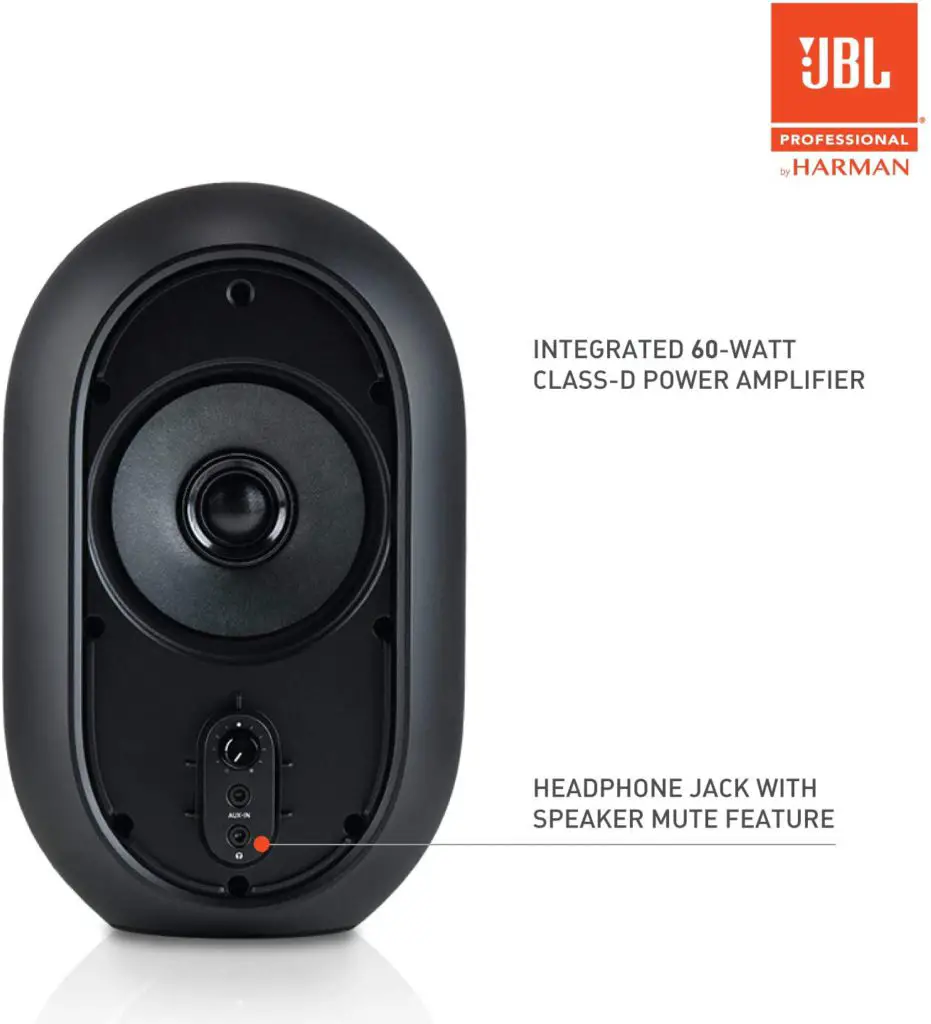
The low tones from this speaker set sound somewhat hollow, even when you have the system optimized for full-spectrum support.
You receive better outputs in the mid-range than high, although the unit stays consistent up to its limit.
The low-frequency port enables you to judge your bass better than other models with a similar design, but it isn’t a pro-level item in this area.
Place the monitoring level at the front-panel volume controls on the master speaker to get an accurate representation in your space.
It connects to a variety of devices that work with your setup, which means the peripherals aren’t going to get in the way.
You’ll find this studio monitor provides a compact setup that’s easy on the budget. That makes it a lot of fun to experiment. It takes the modern production lifestyle seriously.

What Small Studio Monitor Will You Choose?
Several small studio monitors provide opportunities to expand a home recording studio. Whether you record in a closet, bedroom, or soundproofed area, this equipment ensures you can master each audio track accurately.
These are the products with a proven reputation for success in this category. Choose the one that makes the most sense for your setup, embrace your creativity, and have some fun recording!

